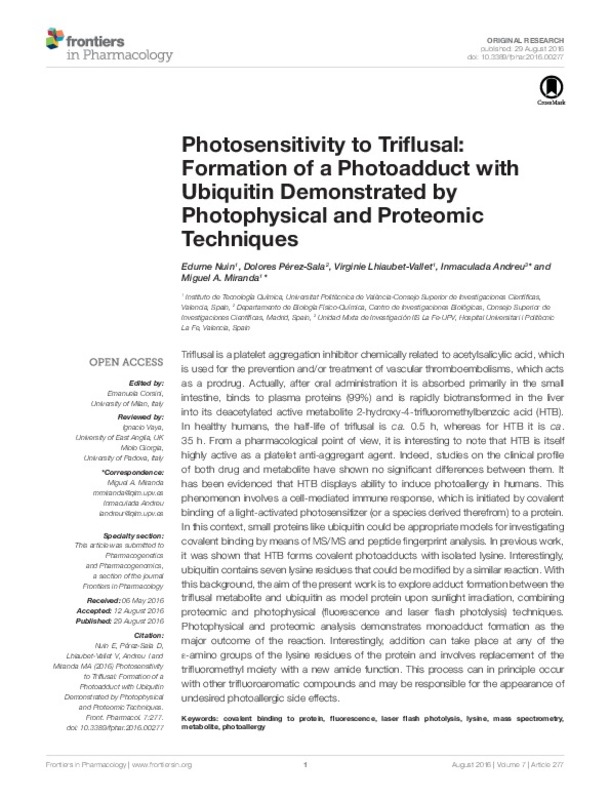Ariza, A., Montañez, M. I., & Pérez-Sala, D. (2011). Proteomics in immunological reactions to drugs. Current Opinion in Allergy and Clinical Immunology, 11(4), 305-312. doi:10.1097/aci.0b013e3283489ae5
Boscá, F., Cuquerella, M. C., Marín, M. L., & Miranda, M. A. (2001). Photochemistry of 2-Hydroxy-4-trifluoromethylbenzoic Acid, Major Metabolite of the Photosensitizing Platelet Antiaggregant Drug Triflusal¶. Photochemistry and Photobiology, 73(5), 463-468. doi:10.1562/0031-8655(2001)0730463pohtam2.0.co2
Caffieri, S., Miolo, G., Seraglia, R., Dalzoppo, D., Toma, F. M., & Henegouwen, G. M. J. B. van. (2007). Photoaddition of Fluphenazine to Nucleophiles in Peptides and Proteins. Possible Cause of Immune Side Effects. Chemical Research in Toxicology, 20(10), 1470-1476. doi:10.1021/tx700123u
[+]
Ariza, A., Montañez, M. I., & Pérez-Sala, D. (2011). Proteomics in immunological reactions to drugs. Current Opinion in Allergy and Clinical Immunology, 11(4), 305-312. doi:10.1097/aci.0b013e3283489ae5
Boscá, F., Cuquerella, M. C., Marín, M. L., & Miranda, M. A. (2001). Photochemistry of 2-Hydroxy-4-trifluoromethylbenzoic Acid, Major Metabolite of the Photosensitizing Platelet Antiaggregant Drug Triflusal¶. Photochemistry and Photobiology, 73(5), 463-468. doi:10.1562/0031-8655(2001)0730463pohtam2.0.co2
Caffieri, S., Miolo, G., Seraglia, R., Dalzoppo, D., Toma, F. M., & Henegouwen, G. M. J. B. van. (2007). Photoaddition of Fluphenazine to Nucleophiles in Peptides and Proteins. Possible Cause of Immune Side Effects. Chemical Research in Toxicology, 20(10), 1470-1476. doi:10.1021/tx700123u
Cho, H.-Y., Jeong, T.-J., & Lee, Y.-B. (2003). Simultaneous determination of triflusal and its major active metabolite, 2-hydroxy-4-trifluoromethyl benzoic acid, in rat and human plasma by high-performance liquid chromatography. Journal of Chromatography B, 798(2), 257-264. doi:10.1016/j.jchromb.2003.09.049
Dikic, I., Wakatsuki, S., & Walters, K. J. (2009). Ubiquitin-binding domains — from structures to functions. Nature Reviews Molecular Cell Biology, 10(10), 659-671. doi:10.1038/nrm2767
Gonzalez-Correa, J. A., & De La Cruz, J. P. (2006). Triflusal: An Antiplatelet Drug with a Neuroprotective Effect? Cardiovascular Drug Reviews, 24(1), 11-24. doi:10.1111/j.1527-3466.2006.00011.x
Herrmann, J., Lerman, L. O., & Lerman, A. (2007). Ubiquitin and Ubiquitin-Like Proteins in Protein Regulation. Circulation Research, 100(9), 1276-1291. doi:10.1161/01.res.0000264500.11888.f0
Hicke, L., Schubert, H. L., & Hill, C. P. (2005). Ubiquitin-binding domains. Nature Reviews Molecular Cell Biology, 6(8), 610-621. doi:10.1038/nrm1701
Hochstrasser, M. (2009). Origin and function of ubiquitin-like proteins. Nature, 458(7237), 422-429. doi:10.1038/nature07958
Hong, J. H., Ng, D., Srikumar, T., & Raught, B. (2015). The use of ubiquitin lysine mutants to characterize E2-E3 linkage specificity: Mass spectrometry offers a cautionary «tail». PROTEOMICS, 15(17), 2910-2915. doi:10.1002/pmic.201500058
Hurley, J. H., Lee, S., & Prag, G. (2006). Ubiquitin-binding domains. Biochemical Journal, 399(3), 361-372. doi:10.1042/bj20061138
Lee, A.-Y., Joo, H.-J., Chey, W.-Y., & Kim, Y.-G. (2001). Photopatch Testing in Seven Cases of Photosensitive Drug Eruptions. Annals of Pharmacotherapy, 35(12), 1584-1587. doi:10.1345/aph.1a007
Lee, A.-Y., Yoo, S.-H., & Lee, K.-H. (1999). A case of photoallergic drug eruption caused by triflusal (Disgren®). Photodermatology, Photoimmunology & Photomedicine, 15(2), 85-86. doi:10.1111/j.1600-0781.1999.tb00062.x
Matías-Guiu, J., Ferro, J. M., Alvarez-Sabín, J., Torres, F., Jiménez, M. D., Lago, A., & Melo, T. (2003). Comparison of Triflusal and Aspirin for Prevention of Vascular Events in Patients After Cerebral Infarction. Stroke, 34(4), 840-848. doi:10.1161/01.str.0000063141.24491.50
McIntyre, J., & Woodgate, R. (2015). Regulation of translesion DNA synthesis: Posttranslational modification of lysine residues in key proteins. DNA Repair, 29, 166-179. doi:10.1016/j.dnarep.2015.02.011
McNeely, W., & Goa, K. L. (1998). Triflusal. Drugs, 55(6), 823-833. doi:10.2165/00003495-199855060-00011
Montanaro, S., Lhiaubet-Vallet, V., Jiménez, M. C., Blanca, M., & Miranda, M. A. (2009). Photonucleophilic Addition of the ε-Amino Group of Lysine to a Triflusal Metabolite as a Mechanistic Key to Photoallergy Mediated by the Parent Drug. ChemMedChem, 4(7), 1196-1202. doi:10.1002/cmdc.200900066
Nagore, E., Pérez-Ferriols, A., Sánchez-Motilla, J., Serrano, G., & Aliaga, A. (2000). Photosensitivity associated with treatment with triflusal. Journal of the European Academy of Dermatology and Venereology, 14(3), 219-221. doi:10.1046/j.1468-3083.2000.00074.x
Oeste, C. L., Díez-Dacal, B., Bray, F., García de Lacoba, M., de la Torre, B. G., Andreu, D., … Pérez-Sala, D. (2011). The C-Terminus of H-Ras as a Target for the Covalent Binding of Reactive Compounds Modulating Ras-Dependent Pathways. PLoS ONE, 6(1), e15866. doi:10.1371/journal.pone.0015866
Pickart, C. M., & Eddins, M. J. (2004). Ubiquitin: structures, functions, mechanisms. Biochimica et Biophysica Acta (BBA) - Molecular Cell Research, 1695(1-3), 55-72. doi:10.1016/j.bbamcr.2004.09.019
Ramirez, J., Martinez, A., Lectez, B., Lee, S. Y., Franco, M., Barrio, R., … Mayor, U. (2015). Proteomic Analysis of the Ubiquitin Landscape in the Drosophila Embryonic Nervous System and the Adult Photoreceptor Cells. PLOS ONE, 10(10), e0139083. doi:10.1371/journal.pone.0139083
Ramis, J., Mis, R., Forn, J., Torrent, J., Gorina, E., & Jané, F. (1991). Pharmacokinetics of triflusal and its main metabolite HTB in healthy subjects following a single oral dose. European Journal of Drug Metabolism and Pharmacokinetics, 16(4), 269-273. doi:10.1007/bf03189971
Renedo, M., Gayarre, J., García-Domínguez, C. A., Pérez-Rodríguez, A., Prieto, A., Cañada, F. J., … Pérez-Sala, D. (2007). Modification and Activation of Ras Proteins by Electrophilic Prostanoids with Different Structure are Site-Selective†. Biochemistry, 46(22), 6607-6616. doi:10.1021/bi602389p
Suryadinata, R., Roesley, S., Yang, G., & Šarčević, B. (2014). Mechanisms of Generating Polyubiquitin Chains of Different Topology. Cells, 3(3), 674-689. doi:10.3390/cells3030674
[-]









